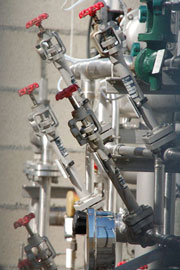Arno's EnergyIdeas (32)
Following the footsteps of the California Hydrogen Highway
During the past three years we attended 45 and hydrogen and fuel cell conferences and trade fairs in 17 countries. Furthermore we are also looking for current H2/FC-highlights to visit. Among others, we did our research at the Morley bus depot in Perth, Australia, where from 2004 to 2007 three hydrogen driven buses ( "100% steam, 100% clean!") were on the road. We saw also the hydrogen fueling station (with dog-washing facilities...) in North Vancouver, BC, Canada. Also, we found six (of which one was already dismanteled) of the much-cited hydrogen fueling stations belonging to the California Hydrogen Highway in "The Golden State "with its 37 million inhabitants.

Photo / Illustration:
Hydrogen Fueling Station, University of California, Irvine, Orange Country, CA
(Arno A. Evers FAIR−PR) |
The first hydrogen refueling activities in California started 1999-2000. "Gouvernator“ Arnold Schwarzenegger released the idea of his "California Hydrogen Highway" with his "Executive Order S-7-04“ on 6 January 2004 with the words: "[...] I will be building a hydrogen highway to take us to the environmental future [...] I intend to show the world that economic growth and the environment can coexist. [...] If you want to see this, then come to California [...]." Schwarzenegger cited as the most important goal that all citizens in California should have access to hydrogen on the state highways by the year 2010 should have.
The plan (in 2004) consisted of 50 to 200 hydrogen filling stations to be built with a maximum distance of 20 miles. Today, in March 2009, 24 or 26 stations are in operation, six of them have already been dismantled. To accomplish this objective set up in 2004 by 2010, there have still between 126 to 176 H2 filling stations in California to go "online". Is this goal at this time still realistic?
Even when it comes to specific information, for example, about the funding of these hydrogen fueling stations it is getting rather "fuzzy". There are many citations like this from the California Fuel Cell Partnership: Some of the [...] today's hydrogen stations are owned by energy companies and are of those operated, others are from universities, local governments, transit and utility company operates. Still others are private stations or facilities of car manufacturers. Only one station in California is operated by a private company, however, more will follow [...]." it continues: [...] Most stations have been funded through a combination of public and private financing through the following programs:
* "[...] The South Coast Air Quality Management District under the
Five-city project provided funds for Burbank, Ontario, Riverside, Santa
Ana and Santa
Monica will be used to hydrogen filling stations for fleet demonstrations
to be build and
operated [...]
* The California Hydrogen Highway Network (CaH2Net) was established in
2004 as a vision created to ensure that a readily accessible hydrogen
infrastructure is available, so that consumers could use vehicles, based
on the ones, which come first to the commercial market.CaH2Net includes 14
stations, which are accessible to the public. Furthermore the program
provides matching funds for the construction of new stations and publicly
available the expansion or upgrading of existing stations [...]
* The Ministry of Energy (DOE) has three programs to the promotion of
Research and development, to ensure hydrogen from a variety of domestic
resources in a clean, safe, reliable and cost-effective way. DOE is
matching funds for the construction of four California hydrogen stations.
[...]
* The Ministry of Transport (DOT) is concentrating its hydrogen program
for public transport. Coordinated through the Federal Transit Authority
(FTA), three California transit agencies are using hydrogen and fuel cell
buses [...]
* Other stations in California are bulit and operated outside of private
co-financing [...]."
Source: California Fuel Cell Partnership.
All in all rather confusing, it lacks concrete means and time information.
Also not really motivating is the difference between the figures announced
with great emphasis in 2004 to built "150 to 200“ hydrogen filling
stations and the 24-26 which are avilable today.
Many hydrogen stations visited by us were placed in a wicked "backyard
atmosphere" (Irvine, Arcata) or were untrustworthy "upgraded"
(Sacramento). Often missing - except for the vehicles to be fueled – were
also any hints about the function of the fueling stations.
Why might this be? In my opinion, the reason is to seek in the point, that
the origin of hydrogen at the moment around the world is - I would say:
"veiled". This is also stated in a recent document of the California
Hydrogen Highway Network: "[...] Hydrogen vehicles will help us to reduce
emissions of greenhouse gases and smog at limit the dependence of our
state of petroleum and creating economic benefits [...]." That statement
is only of limited value, because nowhere, even not in California, larger
quantities of hydrogen are directly produced from renewable energies.
The hydrogen station in the Sacramento Municipal Utility District (SMUD)
is using
large-scale photovoltaics arreys, however, according to official figures,
twelve kilograms of hydrogen per day. Here we should have an exact look to
the circuit's profile: I guess it runs on DC-AC inverters to supply the
grid and parallel with AC-DC rectifiers for electrolysis. An average U.S.
gas station sells about 2.500 gallons of fuel a day. This is equivalent to
the energy content of about 1.500 kg of hydrogen, the SMUD hydrogen
fueling station is able, based on these figures, to produce
photovoltaically 0.8 percent of a "normal" filling stations-day
consumption. If more fuel should be needed, so you can enjoy youself at
any time with the „after heating“ with coal-fired electricity. Than we
could rather promote plug-in electric vehicless...
What to do next? Hydrogen is currently still made from fossil fuels. As
long as this is the case, the environmental arguments are not agreeable.
However, there are smarter ways to procedue hydrogen. They should only be
used. Yes, we can!
Addendum: The latest development of 17 March 2009:
Citation Air Resouces Board:
[...] Notice of Intent to Award Grant Agreement No. RFP. 08-606:
"Establish modular Hydrogen Fueling Stations"
The Air Resources Board intends to award grant agreements to:
Mebtahi Chevron, Harbor City, San Francisco International Airport, San
Francisco;
Shell Hydrogen, Newport Beach, University of California Los Angeles, Los
Angeles [...]."
In my home town Hamburg, Germany, something like this is called "To give
cookies to the baker` s children..."
Links to the news:
http://www.hydrogenhighway.ca.gov/facts/facts.htm
http://www.fair−pr.com/meet−aae/california−hydrogen−highway/index.php
http://www.fair−pr.com/meet−aae/wren2007/fuel−cell−bus−trial.php
Date: 24.03.2009 |
